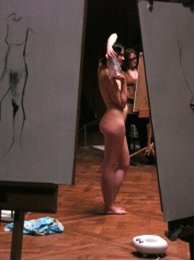AS / A Level Art and Design
The exam boards prescribe the curriculum for GCE Art and Design. There are four main exam boards:
All these exam boards offer at least one Art and Design GCE. If your audience is likely to be from local schools it is worth finding out what boards they use and get advice from history teachers at those schools. The criteria of GCE A Levels and AS Levels has been revised recently and references are to the syllabus from September 2008.

Naked Bodies life-drawing workshop for Key Stage 4/A Level students.
Based on discussion of the nude tradition, this workshop involves working in the Picture Gallery among the portraits. The model’s poses refer to images known by the students, such as Ingres’ Woman holding an urn and Uglow’s Double Square, Double Square.
© The Holburne Museum of Art
Art and Design GCEs are divided into ‘endorsements’ and the most relevant to portraiture are Fine Art, Photography – lens and light based media, and Critical and Contextual Studies. Fine Art comprises painting, drawing, printmaking, sculpture, lens-based imagery and alternative media.
It depends on the nature and media of your portrait collection as to what learning programmes you could run. Workshops enabling observation and evaluation for work journals and creative practices that schools / colleges are unlikely to offer.
A good idea: Naked Bodies
Holburne Museum of Art runs a one day workshop on the range of ways the nude / naked body has been used in art, looking at different approaches in the Fine and Applied Arts and different cultural approaches, from Classicism (Poussin) to Realism (Rembrandt) Modernism and Post Modernism. It also investigates the body as integral to the painting and the concept of the male gaze.
The workshop begins with a slide show and then moves into the gallery, where students find and draw examples of the nude and plan their drawing session. The afternoon comprises a drawing session with a nude model, which examines the anatomy of poses, considers the world of the drawing studio and looks at contrasting perceptions of the naked body. While the model poses in certain attitudes, students also pose in that way so that they fully understand the position they are drawing.
Return to ‘Key Stage Five / Sixth Form College / Further Education (16+)′
